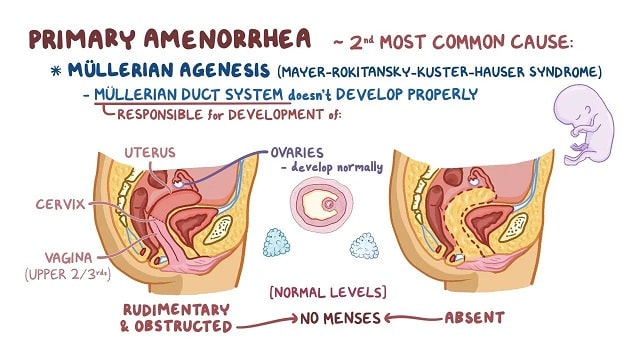Amenorrhea is a condition when a woman does not menstruate or have a period. This condition occurs if a woman does not menstruate for 3 consecutive cycles or more, or if she has never menstruated by the age of 15. Amenorrhea is divided into two, namely:
- Primary amenorrhea, which is when a girl has experienced other changes during puberty, but has not yet menstruated and is 15 years old.
- Secondary amenorrhea, which is the condition of not menstruating for more than three cycles or 6 months.
Symptoms of Amenorrhea
Some symptoms of this condition include:
- No menstruation.
- Hair loss.
- Headache.
- Pelvic pain
- Acne appears.
- Visual disturbances.
- Fine hair grows on the face.
- Discharge from the nipples.
Risk Factors for Amenorrhea
Some risk factors for this condition include:
- Family history of amenorrhea.
- Eating disorders, such as anorexia or bulimia.
- High-intensity exercise.
- Obesity
- Genetics, such as having a change in the FMR1 gene, which also causes Fragile X1 syndrome.
Causes of Amenorrhea
Some of the causes include:
- Reproductive organs that are not fully developed, such as the absence of a uterus or vagina, narrowing and blockage of the cervix, and a vagina that is divided into 2 parts (vaginal septum).
- Natural hormonal changes, such as during pregnancy, breastfeeding, and menopause.
- Caused by the use of several types of drugs, one of which is contraceptive drugs.
- Being 10 percent underweight can cause hormonal imbalances that stop ovulation, such as in people with bulimia and anorexia.
- Stress triggers changes in the function of the hypothalamus in the brain, which is the area that controls the menstrual cycle.
- Excessive exercise or physical activity can disrupt the menstrual cycle.
- Disorders that cause hormonal imbalance, such as polycystic ovary syndrome, thyroid disorders, pituitary tumors, or premature menopause.
Diagnosis of Amenorrhea
The doctor will diagnose by conducting a medical interview, physical examination, and supporting examinations, such as:
- Thyroid Function Test, to measure the amount of thyroid-stimulating hormone (TSH) in the blood to see if the thyroid is functioning properly. Thyroid problems can cause amenorrhea.
- Ovarian Function Test, to measure the amount of follicle-stimulating hormone (FSH) in the blood to determine how the ovaries are performing.
- Androgen test, to check the level of androgen in the blood.
- Prolactin Test. Low levels of the hormone prolactin may be a sign of a pituitary tumor.
- Ultrasonography (USG) to determine the cause of amenorrhea.
- Magnetic resonance imaging (MRI) of the brain if a pituitary or hypothalamic abnormality is suspected.
- Computerized tomography (CT scan) of the abdomen and pelvis to look for abnormalities of the uterus or ovaries.
Complications of Amenorrhea
Some complications caused by amenorrhea include:
- Infertility or sterility, because ovulation does not occur so that pregnancy cannot occur.
- Osteoporosis, caused by low estrogen levels.
Amenorrhea Treatment
Treatment is given based on the cause, including:
- Surgery, hormone therapy or both are performed if amenorrhea is caused by congenital birth defects that result in anatomical abnormalities.
- Administration of drugs, such as medroxyprogesterone in women with adult-onset adrenal hyperplasia, hypothyroidism, and premature ovarian failure.
- Weight loss through diet, exercise, and metformin can be done in women with polycystic ovary syndrome (PCOS).
- Consultation with a genetic specialist for women who experience a lack of menstruation due to hereditary factors.
Prevention of Amenorrhea
Some preventive measures that can be taken include:
- Healthy lifestyle changes.
- Get enough rest.
- Avoid excessive exercise or activity.
- Maintain a healthy diet by not holding back your appetite.
- Avoid prolonged stress.
- Record and pay close attention to your menstrual cycle.
